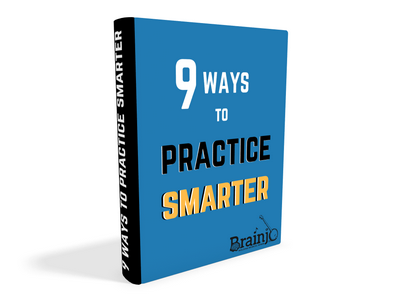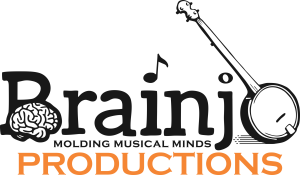How To Use Tab Responsibly
Here I’m going to review with you the system I recommend for learning new songs from tab on the banjo, whether or not you’re learning clawhammer or fingerstyle banjo.
Why do you need a system?
One of the primary goals of for any musician, and of the Breakthrough Banjo course, is to develop musical fluency, or the ability to take imagined musical sounds in your mind and then translate those to movements of your hands and fingers, so those sounds in your mind are transformed into the sounds of the banjo.
(RELATED: Subscription to the Breakthrough Banjo course is currently FREE for 30 days. Click here to learn more.)
And that means that you ultimately want to build a banjo playing brain that doesn’t require any musical notation or tablature for you to play.
That might lead to the mistaken impression that you shouldn’t use written notation of any sort when learning to play. But that’s not the case at all.
What it does mean, however, is that we must be careful and intentional about the specific way in which we use tablature. And that’s what the Brainjo Tune Learnin’ System is for.
The goal here then is to provide you a system for learning new tunes along the way to fluency that:
#1: Reinforces and grows the skills needed for musical fluency AND
#2 – Doesn’t create dependency on written notation (banjo tab) to play.
In this tutorial, we’ll take the example of the song “Blue Ridge Cabin Home” and demonstrate how to learn it using this process.
Step 1: Get the tune in your head.
One of the most common mistakes people make, which can lead to a host of potential problems, is in trying to learn how to play a tune before they actually know how it sounds. The worst example of this would be taking a tab of a song you’ve never heard and trying to play it. Don’t do that.
Before you set down to play any tune, make sure you have its basic melody in your head.
This sort of thing is easier to do with songs, as we all have an easier time remembering melodies when they’re attached to words. And so this is one of the main reasons that most of the early music in the Breakthrough Banjo course is in the form of songs (not instrumental-only music).
And so with a song, the rule is simple: don’t try to learn to play it on the banjo until you can sing it, start to finish.
Here is a sample of me singing and playing the basic melody of Blue Ridge Cabin Home (singing melody samples are given for all the songs taught as part of the Breakthrough Banjo course):
Singing “Blue Ridge Cabin Home”:
Playing “Blue Ridge Cabin Home”:
Once you start moving onto instrumentals, aka “tunes,” you’ll instead want to be able to hum or whistle the basic melody.
Step 2: Learn the tune in chunks.
Don’t try to learn the whole thing at once, especially early on.
Instead, break the song down into pieces, and learn those separately. Those chunks can be of whatever length feels manageable to you (which will likely be smaller in the beginning). Anywhere from one to four measures is reasonable (this is a variation of the “labyrinth” technique).
Step 3: Play it without the tab as soon as you can.
As you’re learning each chunk, test yourself by playing through it without looking at the tab. If you find that you’re unable to remember it, then consider shortening the length of the chunk you’re trying to learn. As you continue to do this, you will find the amount you can remember will grow.
Step 4: Play the song with an external timekeeping device.
Anything that keeps regular time is suitable for playing along with. The most traditional thing to use is the metronome, however, I prefer to use the “Beats for Banjo” tracks (click here to check out the “Beats for Banjo” practice tracks).
If available, you can also use a backup track with the chord changes. Here’s a sample of the backup track for Blue Ridge Cabin Home from the Breakthrough Banjo course.
(RELATED: You’ll note that these are “Brainjo level 2” arrangements. Click here for more information on what the Brainjo levels mean.)
You’ll notice that the tablature disappears after I’ve played through the song once, which is by design! The goal is for you play through the song without the tab:
Tutorial and Practice Track – 80 bpm
Tutorial and Practice Track – 100 bpm
If you find that you’re unable to play through the tune without the tab in front of you, then go back to step 2.
The ultimate goal is for you to be able to play through the song in time with the backup tracks without having to look at the tab.
Bonus Steps
If you want to take things even further and accelerate the development of your ear and musical fluency, then also incorporate steps 5 through 7.
Step 5: Record yourself playing through the song.
Make a recording of you playing through the song. Speed doesn’t really matter – just play it at the speed that allows you to play through the song cleanly and with good timing (if you get into habit of doing this with every new song you learn, then you can build a playlist of your personal repertoire, which I strongly encourage!).
Step 6: Listen to your recording and visualize playing it.
Periodically listen back to your recordings. And, as you listen back, visualize yourself playing through the song. Imagine yourself holding the banjo, and what you’re doing with your hands as you’re listening back to the recording of yourself playing through it.
If you’re unable to “see” what to do with your hands throughout the whole song, then revisit the song with the banjo in hand to fill in the memory gaps.
Step 7: Visualize without the recording.
Now imagine yourself playing through the entire song without the recording. As you make the movements of your hands, hear the sounds that are coming out of the banjo. If you’re unable to make it through the entire song, go back to step 6.
Voila!
Note that the ONLY way for you to achieve Step 7 is if you’ve built networks on the brain that connect the movements of your hands to the sounds of your banjo, which is exactly the type of brain network needed to be a fluent musician. And a surefire way to ensure that you’re building brain networks that don’t incorporate tablature (even if you use tab in the learning process).
9 Ways To Practice Smarter
As the preceding discussion on learning new tunes illustrates, it’s not what you practice that determines your success in learning the banjo, but HOW you practice it.
And if you enjoyed this lesson on the tune learnin’ process, and want to learn more about how to practice smarter, not hearder, you’ll probably enjoy the “9 Ways to Practice Smarter” ebook and video.
Click Here to download the book
In the 9 Ways To Practice Smarter video and accompanying book, you’ll learn how to:
- Maximize your practice time for best results
- Avoid the most common practice mistakes
- Eliminate wasted time practicing
- Stimulate your brain to change
- Ensure your brain changes EXACTLY how you want
- Know WHAT to practice WHEN
- Know exactly when it’s time to move forward
- Practice so that you no longer need tab
- Develop your ability to play by ear
- Maximize the advantages of having an adult brain
- Develop the brain of a master player


